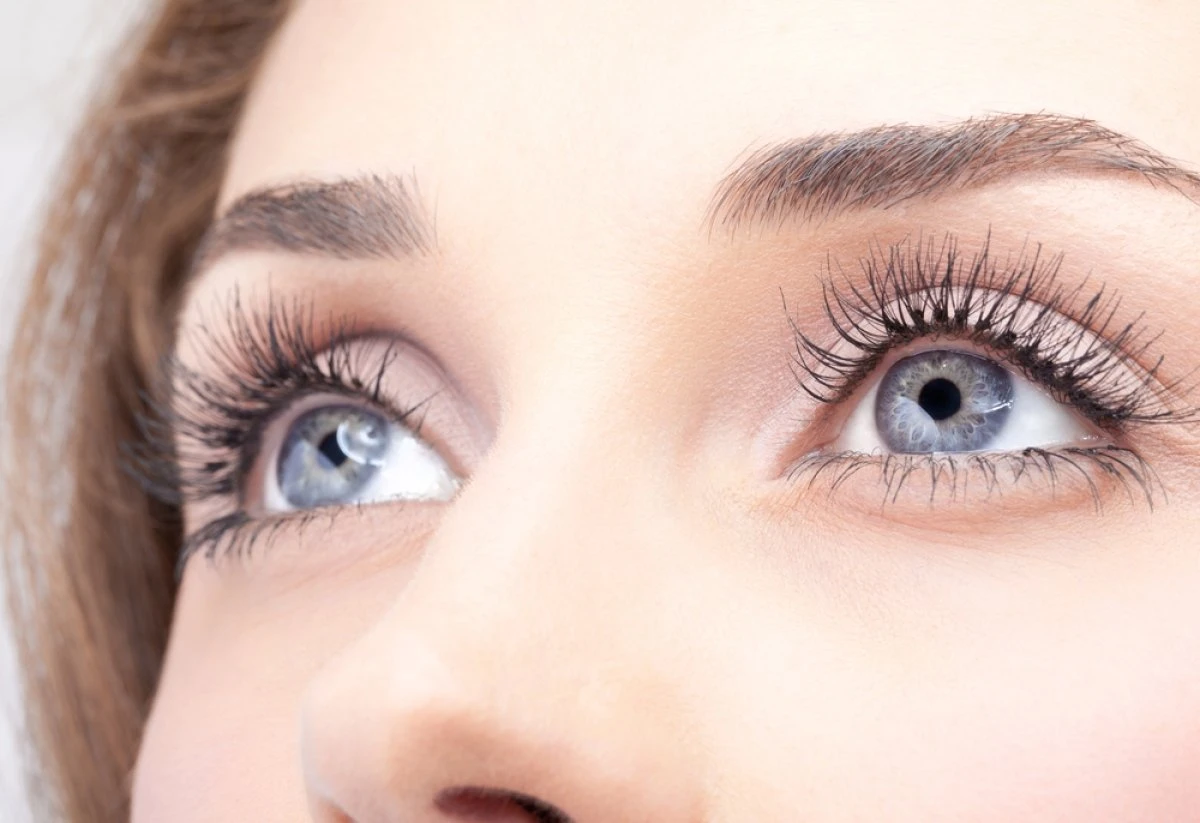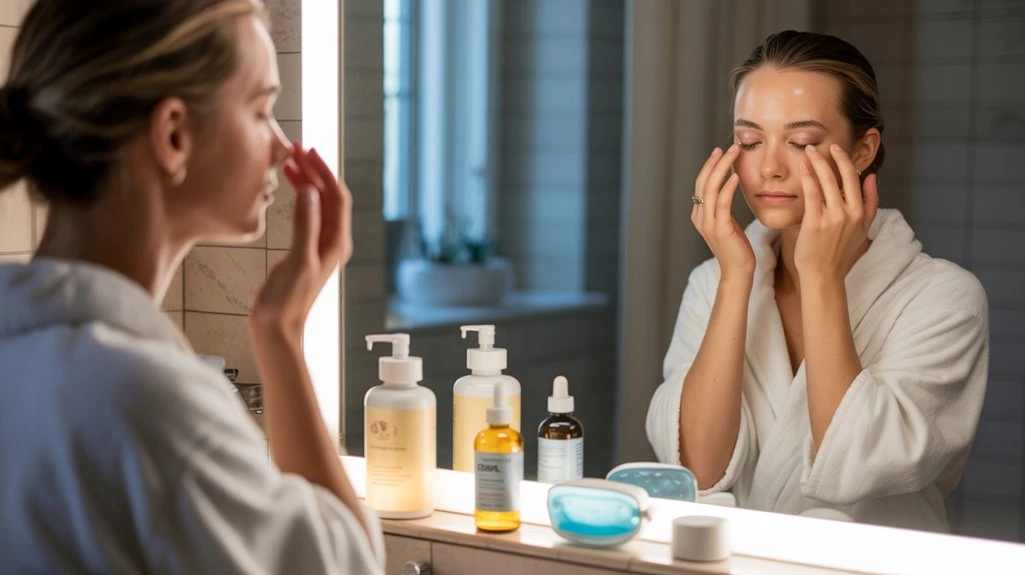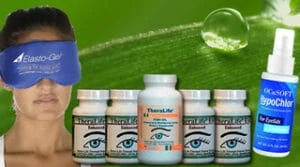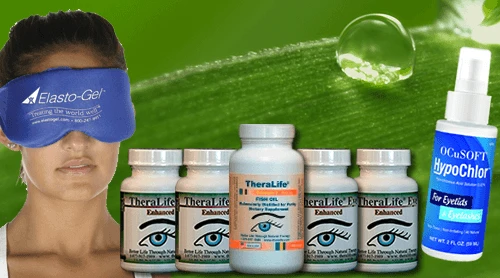To effectively manage ocular rosacea, consider the unique benefits of TheraLife’s products, which are designed to support eye health from the inside out. Begin by identifying and eliminating environmental and lifestyle triggers, such as irritants and extreme conditions. TheraLife offers the only oral eye treatment care, providing a comprehensive approach to stabilizing the tear film and reducing symptoms. Their products include omega-3 supplements and other anti-inflammatory nutrients that help reduce ocular surface inflammation. By using TheraLife’s doctor-recommended medications as prescribed, you can achieve optimal results. Consistently applying these interventions can dramatically reduce symptoms, offering a holistic solution for ocular rosacea. For more information on TheraLife’s innovative approach and product benefits, explore their resources and practical methods for managing eye health.
Powerful Ocular Rosacea Relief With TheraLife
Chronic dry eye is a significant feature of ocular rosacea.
Treating dry eyes will reduce inflammation and keep ocular rosacea under control
Key Takeaways
- Identified and avoided environmental and lifestyle triggers that worsened my ocular rosacea symptoms.
- Adopted a daily eyelid hygiene routine with gentle cleansing and specialized eyelid wipes.
- Incorporated anti-inflammatory nutrition and omega-3 supplements to reduce ocular surface inflammation.
- Used doctor-recommended topical and oral medications tailored to my condition.
- Applied moist heat therapy with warm compresses twice daily to improve meibomian gland function.
Identifying and Eliminating Triggers

Although ocular rosacea presents with variable symptoms, recognizing and eliminating specific environmental and lifestyle triggers is essential for effective management. You should systematically evaluate personal exposure to environmental factors such as extreme temperatures, wind, sun, and low humidity, since these conditions can exacerbate ocular surface inflammation. Additionally, minimizing contact with potential irritants—like smoke or air pollution—reduces the likelihood of symptom flares. Lifestyle changes, including dietary modifications, limiting alcohol intake, and managing stress, have been shown to decrease the frequency and severity of episodes. Maintaining a symptom diary can help you identify patterns related to environmental exposures or specific behaviors. Regular eyelid hygiene practices, such as lid margin massage and warm compresses, can also significantly improve symptoms by enhancing meibomian gland function and tear film stability.
Adopting a Consistent Eyelid Hygiene Routine
Once you’ve minimized exposure to known triggers, maintaining a consistent eyelid hygiene routine forms a cornerstone of ocular rosacea management. Daily eyelid hygiene reduces microbial load, decreases meibomian gland dysfunction, and limits inflammatory exacerbations. Utilize eyelid wipes specifically formulated for sensitive periocular skin, and prioritize gentle cleansing to avoid mechanical trauma. Evidence supports that thorough yet non-abrasive cleansing optimizes tear film stability and minimizes symptom recurrence. Consistent treatment regimens are essential for chronic condition management, including allergy management and environmental control strategies.
Consider the following routine:
| Step | Purpose | Key Product/Action |
|---|---|---|
| Warm Compress | Loosens secretions | Clean washcloth |
| Eyelid Wipes | Reduces debris/bacteria | Hypoallergenic wipes |
| Gentle Cleansing | Minimizes inflammation | Mild cleanser solution |
| Drying | Prevents moisture buildup | Soft towel |
Consistency in these steps underpins long-term disease control and symptom reduction.
Incorporating Anti-Inflammatory Nutrition
While research on dietary interventions for ocular rosacea continues to evolve, emerging evidence indicates that an anti-inflammatory diet may help modulate disease activity.
You should consider incorporating anti-inflammatory foods such as leafy greens, fatty fish rich in omega-3 fatty acids, and berries, as these have demonstrated potential in reducing systemic inflammation.
Limiting processed foods, refined sugars, and excess saturated fats may further decrease inflammatory triggers.
In addition to whole foods, certain dietary supplements—such as omega-3 fatty acids—have been studied for their efficacy in ameliorating ocular surface inflammation.
It’s important to note that omega-3 fish oil improves oil film production by meibomian glands, which can alleviate symptoms of dry eyes.
Consult your healthcare provider before initiating supplements to guarantee safety and appropriateness for your condition.
Using Doctor-Recommended Medications

Effective management of ocular rosacea often necessitates the use of doctor-recommended medications to control symptoms and prevent complications. Your ophthalmologist may prescribe topical treatments such as metronidazole or azithromycin ophthalmic solutions, which target underlying inflammation and reduce bacterial colonization of the eyelid margins. For moderate to severe cases, oral prescription options like doxycycline or tetracycline are frequently utilized due to their anti-inflammatory and antimicrobial properties. These systemic agents can considerably decrease eyelid swelling, redness, and meibomian gland dysfunction. Adherence to the recommended dosing regimen is essential for ideal therapeutic results and minimizing recurrence. It’s important to avoid self-medicating and consult your specialist for tailored recommendations. Combination therapies can enhance treatment outcomes by incorporating both oral and topical solutions for comprehensive symptom relief. With consistent use of these evidence-based treatments, you can achieve substantial relief from ocular rosacea symptoms and prevent disease progression.
Embracing Moist Heat Therapy
Although pharmacological therapies are foundational, incorporating moist heat therapy plays a critical adjunctive role in managing ocular rosacea. By applying warm compresses to your eyelids, you enhance meibomian gland function, promote glandular secretion, and alleviate lid margin inflammation. The therapy benefits include improved tear film stability and reduced ocular surface discomfort. Evidence suggests that consistent use of moist heat decreases both blepharitis symptoms and exacerbations of ocular rosacea. For ideal results, use a clean, damp, warm compress for 10–15 minutes twice daily. Regular eye checks help monitor the condition and adjust treatments as needed for optimal outcomes.
| Parameter | Clinical Effect | Therapy Benefits |
|---|---|---|
| Temperature | Enhances secretion | Reduces gland obstruction |
| Duration | Prolonged efficacy | Maximizes anti-inflammatory response |
| Frequency | Symptom reduction | Sustains tear film stability |
| Hygiene | Infection control | Prevents secondary complications |
Powerful Ocular Rosacea Relief With TheraLife
Chronic dry eye is a significant feature of ocular rosacea.
Treating dry eyes will reduce inflammation and keep ocular rosacea under control
Frequently Asked Questions
Is Ocular Rosacea Contagious to Others?
Ocular rosacea isn’t contagious, so you won’t transmit it to others through direct or indirect contact. It’s a chronic inflammatory condition, not an infection.
Focus on symptom management and explore treatment options with a healthcare provider to reduce flare-ups and discomfort. You may use prescribed topical or oral medications, practice good eyelid hygiene, and avoid triggers.
Evidence indicates that early intervention improves outcomes and helps maintain long-term control of ocular rosacea symptoms.
Can Children Develop Ocular Rosacea?
Just as the rarest blooms appear in unexpected gardens, children can indeed develop ocular rosacea, though it mainly affects adults.
You should watch for symptoms like eyelid redness, irritation, or a gritty sensation. Early diagnosis is essential, as symptom management may require artificial tears, eyelid hygiene, or prescribed antibiotics.
Discuss treatment options with a pediatric ophthalmologist to mitigate long-term complications and optimize ocular surface health for young patients.
Will Ocular Rosacea Affect My Vision Permanently?
Ocular rosacea can impact your vision health if left untreated, potentially leading to long term effects such as corneal damage or visual impairment.
However, most patients don’t experience permanent vision loss if they seek timely intervention.
Clinical evidence shows that managing inflammation and adhering to prescribed therapies can protect ocular structures.
It’s important to monitor symptoms and consult your ophthalmologist regularly to minimize risks and preserve your long-term visual function.
Are There Any Cosmetic Products I Should Avoid?
Imagine you’re selecting mascara, and by coincidence, you notice certain skincare ingredients—fragrances, alcohol, and preservatives—on the label.
You should avoid such products, as evidence indicates they may exacerbate ocular rosacea symptoms.
Opt for hypoallergenic, fragrance-free makeup alternatives, and always remove eye makeup thoroughly.
Clinical studies suggest that non-comedogenic formulations with minimal irritants are preferable to minimize inflammation and ocular surface discomfort.
Consult your ophthalmologist before introducing new products.
Can Contact Lenses Worsen Ocular Rosacea Symptoms?
Contact lenses can exacerbate ocular rosacea symptoms by increasing ocular surface irritation and dryness.
You should maintain strict contact lens hygiene to minimize the risk of secondary infections or inflammation.
It’s advisable to consult eye care specialists regularly to monitor your ocular health and receive evidence-based recommendations.
Some patients may need to limit or discontinue contact lens use if symptoms persist or worsen, as recommended by a healthcare professional specializing in ocular surface disease.
Powerful Ocular Rosacea Relief With TheraLife
Chronic dry eye is a significant feature of ocular rosacea.
Treating dry eyes will reduce inflammation and keep ocular rosacea under control
Conclusion
By incorporating Theralife’s unique oral eye treatment care, you can reclaim comfort and clarity from the fog of ocular rosacea. Theralife is the only company providing this innovative approach, ensuring a comprehensive recovery. Their regimen involves identifying triggers, maintaining diligent eyelid hygiene, optimizing nutrition, adhering to prescribed medications, and using moist heat therapy. This evidence-based treatment is designed to restore the health of your eyes, like clearing a clouded lens. Clinical studies support each method, offering hope grounded in science, so you don’t just manage symptoms but rediscover the brilliance of healthy eyes.
REFERENCES
- 1.Two AM, Wu W, Gallo RL, et al. Rosacea: part I. Introduction, categorization, histology, pathogenesis, and risk factors. J Am Acad Dermatol. 2015;72:749–760; quiz 759–760. [DOI] [PubMed] [Google Scholar]
- 2.Culp B, Scheinfeld N. Rosacea: a review. P T. 2009;34:38–45. [PMC free article] [PubMed] [Google Scholar]
- 3.Alvarenga LS, Mannis MJ. Ocular rosacea. Ocul Surf. 2005;3:41–58. [DOI] [PubMed] [Google Scholar]
- 4.Vieira AC, Mannis MJ. Ocular rosacea: common and commonly missed. J Am Acad Dermatol. 2013;69:S36–S41. [DOI] [PubMed] [Google Scholar]
- 5.Rainer BM, Kang S, Chien AL. Rosacea: epidemiology, pathogenesis, and treatment. Dermatoendocrinol. 2017;9:e1361574. [DOI] [PMC free article] [PubMed] [Google Scholar]
- 6.Webster GF. Rosacea. Med Clin North Am. 2009;93:1183–1194. [DOI] [PubMed] [Google Scholar]
- 7.Heisig M, Reich A. Psychosocial aspects of rosacea with a focus on anxiety and depression. Clin Cosmet Investig Dermatol. 2018;11:103–107. [DOI] [PMC free article] [PubMed] [Google Scholar]
- 8.Wilkin J, Dahl M, Detmar M, et al. Standard classification of rosacea: report of the national rosacea society expert committee on the classification and staging of rosacea. J Am Acad Dermatol. 2002;46:584–587. [DOI] [PubMed] [Google Scholar]
- 9.Geng RSQ, Slomovic J, Bourkas AN, et al. Ocular rosacea: the often‐overlooked component of rosacea. JEADV Clin Pract. 2024;3:1349–1363. [Google Scholar]
- 10.Patel NV, Gupta N, Shetty R. Preferred practice patterns and review on rosacea. Indian J Ophthalmol. 2023;71:1382–1390. [DOI] [PMC free article] [PubMed] [Google Scholar]





